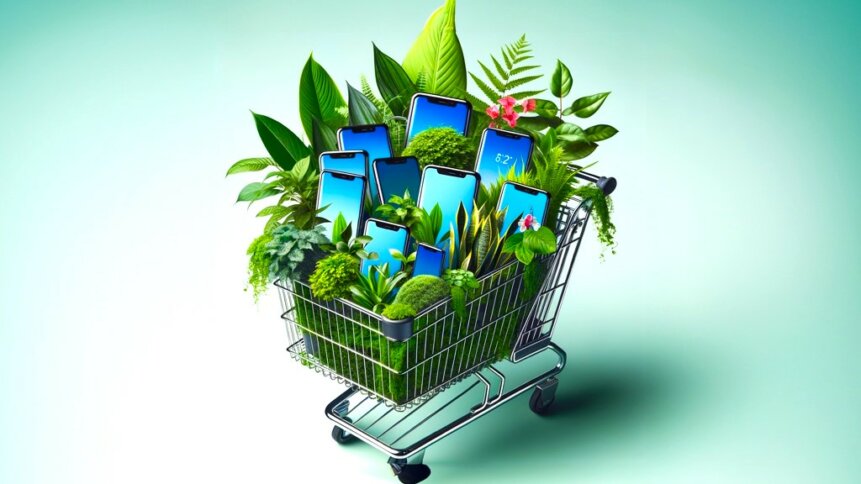Green Friday? Circular economy trends for 2024

|
Getting your Trinity Audio player ready...
|
• Circular economy trends in technology could play a significant role in building sustainability into the industry.
• The circular economy depends on three phases – recover, refresh, and remarket.
• Many tech items can be recycled at near net-zero cost.
Online retailers of refurbished technology are encouraging shoppers to opt for a Green Friday when looking for bargains on November 24th. However, it’ll take more than a change of messaging for the circular economy to achieve its full potential, and one of the biggest trends is happening right inside the buying basket.
In the past, consumers may have received a voucher for handing in their old tech when purchasing a new device. Early adopters could have drawers full of electronic goods, having never gotten around to selling unwanted items – despite their best intentions. And this is where circular technology economy enablers – such as Alchemy – are helping to change behavior through device trade-in services and systems.
“The experience from the customer perspective wasn’t good,” James Murdock – Alchemy co-founder – told TechHQ, referring to the gap that he and his colleagues saw in the market when setting up the business back in 2017. Since then, Alchemy has grown to become one of the largest and fastest-growing circular tech companies in the world.
Its services fall into three categories, which the company – headquartered in Dublin, Ireland, and with global operations – refers to as ‘recover,’ ‘refresh,’ and ‘remarket.’
Recover, refresh, remarket – circular economy trends
“When a user buys a new tech product, we enable them to trade in their current device,” writes Alchemy on its website. “We do this for some of the world’s most prominent retailers and carriers, as well as managing large programs for enterprises and their resellers.”
This first action is key when it comes to circular economy trends – it removes the roadblocks that stopped purchasers of new devices from contributing to the secondary technology market. As Murdock points out, buyers of new devices are important as they start the circle.
On TechHQ we’ve written about how firms such as Back Market recreate the buzz of buying a new device to attract buyers of refurbished smartphones and other electronics. And there’s more to expanding the circular technology economy than just getting consumers to avoid shiny new things.
Happy #earthday2023
Let's recognize one of the most impactful sectors to reduce e-waste
The Global #refurbished #smartphones industry grew by 5% in 2022 while new smartphone shipments fell.#CounterpointTR #circulareconomy #sustainability #Apple #Samsung pic.twitter.com/cee81qBiVW— Glen (@GlenCardoza) April 22, 2023
In fact, Murdock’s comments suggest that there’s room for different types of purchaser. “We are enabling the journey at the same time as shoppers are buying the new thing,” he said. “And that’s strengthening the circular economy.”
He draws parallels between top-end smartphone firms and leading carmakers, explaining how devices made by premium brands such as Apple and Samsung hold their value, much like vehicles manufactured by BMW, Mercedes, and Audi fare well in second-hand automotive markets.
Reuse and repurpose
Helping electronics partners to recover, refresh, and remarket devices allows customers to experience brands at lower price points, and can contribute directly to profits. For example, automakers add revenue through servicing, even though the customer didn’t buy new. And cell phone carriers benefit financially from all subscriber devices connected to their networks – not just ones that are box-fresh.
Considering other circular economy trends, Murdock agrees that blockchain technology is an interesting idea for product passports – particularly at the component level. However, there are operational issues to consider.
Running a refurbished technology business is cash-intensive, requiring large amounts of working capital and lines of credit. And no firm is going to invest heavily in setting up a product passport scheme only to see competitors reap the rewards.
That being said, larger players such as Alchemy do see the same devices come through their system multiple times as owners’ device needs and tastes change. Apple’s iPhones are reportedly designed for a seven-year lifecycle, which means that devices can efficiently serve three owners or more before being sent for recycling.
Murdock and his colleagues – today, the firm has over 350 staff – help clients not just with the mechanics of how to participate in the circular economy, the team brings expertise in pricing too. For example, services include residual value modeling and commercial forecasting.
“The iPhone is worth more today than it’s ever been worth, as a percentage of its new value,” Murdock reveals.
Devices will fall in price over their lifetime, but there will still be movements up and down. And things can change quickly when global events impact supply chains.
Money saving RFP knowhow
In conversation with TechHQ, Murdock notes that North America is no laggard when it comes to capitalizing on the savings of buying used devices. In the US, organizations are ahead in recognizing that circular economy trends include being able to write an RFP that specifies not just the number, age, and types of devices required – for example, by a large school or college – but also spells out the equipment that will be traded in as part of the contract.
However, sustainable purchasing decisions are less common elsewhere, with many public bodies and governments continuing to buy new devices – even when capable refurbished technology is available in large quantities.
Trends in other sectors, such as fashion, could help to change that – where buying vintage clothes and choosing items made from recycled materials is seen as responsible, given the resources needed to grow cotton.
Murdock sees the use of social media platforms such as TikTok as another driver of the circular economy, especially when they include e-commerce features. And he wants more to be done to accept old cables and chargers – noting how Apple’s switch from Lightning to USB-C designs will add to the amount of e-waste.
The good news is that many of these items can be recycled at near net-zero cost. In other words, the value of the reclaimed materials supports that step of the circular journey. And the incentives are stronger still for precious and rare-earth materials found in chips and other high-end electronics. Even sim cards can be turned into gold.









